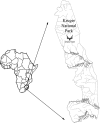Case-control study to determine whether river water can spread tetracycline resistance to unexposed impala (Aepyceros melampus) in Kruger National Park (South Africa)
- PMID: 18978077
- PMCID: PMC2612227
- DOI: 10.1128/AEM.01808-08
Case-control study to determine whether river water can spread tetracycline resistance to unexposed impala (Aepyceros melampus) in Kruger National Park (South Africa)
Abstract
A case-control study was performed in the Kruger National Park (KNP), South Africa, to find out whether impala (Aepyceros melampus) were more likely to harbor tetracycline-resistant Escherichia coli (TREC) in their feces when they drank from rivers that contained these bacteria than when they drank from rivers that were uncontaminated with TREC. The following five perennial rivers were selected: the Crocodile, the Letaba, the Olifants, the Sabie, and the Sand. Samples of river water (n = 33) and feces (n = 209), collected at 11 different sites, were cultured for E. coli. The resulting colonies were screened for tetracycline resistance by use of the Lederberg replica plating method (breakpoint, 4 mg/liter). A resistant and/or a susceptible isolate was then selected from each sample and subjected to the CLSI MIC broth microdilution test for tetracyclines. Among the 21 water specimens contaminated by E. coli, 19.05% (n = 4) were found to be resistant by the MIC method (breakpoint, >/=8 mg/liter). This led to the Crocodile, Olifants, and Letaba rivers being classified as TREC positive. Among the 209 impala feces sampled, 191 were positive for the presence of E. coli (91.38%). Within these (n = 191), 9.95% (n = 19) of the isolates were shown to be TREC by the MIC method. It was found that 1.11% (n = 1) of the E. coli isolates cultured from the feces of the control group (n = 90) were TREC, in comparison with 17.82% (n = 18) of those in feces from the exposed group (n = 101). The calculation of the odds ratio showed that impala drinking from TREC-contaminated rivers were 19.3 (2.63 to 141.69) times more likely to be infected with TREC than were unexposed impala. This is a significant finding, indicating that surface water could be a possible source of antimicrobial resistance in naïve animal populations and that impala could act as sentinels for antimicrobial resistance.
Figures
References
-
- Aarestrup, F. M., A. M. Seyfarth, H. D. Emborg, K. Pedersen, R. S. Hendriksen, and F. Bager. 2001. Effect of abolishment of the use of antimicrobial agents for growth promotion on occurrence of antimicrobial resistance in fecal enterococci from food animals in Denmark. Antimicrob. Agents Chemother. 45:2054-2059. - PMC - PubMed
-
- Berry, D., C. Xi, and L. Raskin. 2006. Microbial ecology of drinking water distribution systems. Curr. Opin. Biotechnol. 17:297-302. - PubMed
-
- Bloland, P. B. 2001. Drug resistance in malaria. Department of Communicable Disease Surveillance and Response, WHO, Geneva, Switzerland. www.who.int/entity/drugresistance/publications/WHO_CDS_CSR_DRS_2001_4/en/. Accessed June 2008.
Publication types
MeSH terms
LinkOut - more resources
Full Text Sources
Medical



